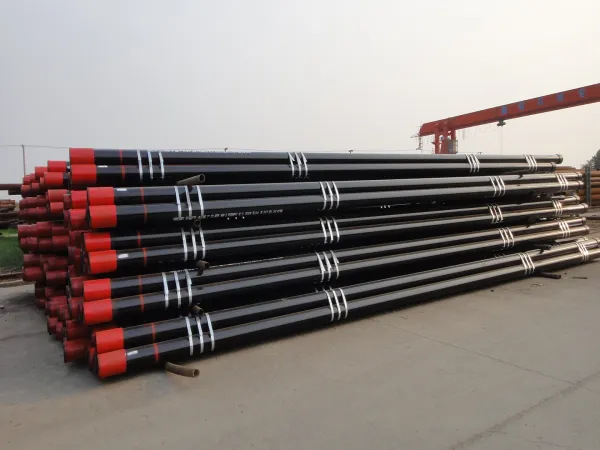API 5CT H40
casing and tubing are vital components in oil and gas operations. They are widely used to protect the wellbore and ensure the safety and efficiency of drilling and production operations. This article will introduce the specifications, applications and manufacturing processes of API 5CT H40 pipes in detail to help you fully understand this type of casing and tubing.
Introduction to API 5CT H40 Casing and Tubing
API 5CT H-40 pipe is a special steel grade with a relatively low yield strength, so it is not common and many suppliers do not stock this product. Although H40 steel grade is not as widely used as other high-strength steel grades, it is still an important choice in some medium-strength applications, especially for resisting oil and gas well environments with low corrosion and moderate pressure. H40 grade pipes are often used for well casing and tubing to protect the wellbore and prevent oil and gas wells from collapsing during operations.
Grade H40: The "H40" designation in API 5CT H40 OCTG casing refers to the specific grade of steel used to manufacture the casing. In this case, the "H" represents the material's minimum yield strength, which is 40,000 pounds per square inch (psi). Yield strength is an important mechanical property of steel because it represents the maximum stress a material can withstand before permanent deformation occurs.
OCTG Casing: Oil Country Tubular Goods (OCTG) casing is a critical component used in the construction of oil and gas wells. Casing performs several essential functions, including providing structural support to the wellbore, preventing formation collapse, isolating different formations, and facilitating the installation of various downhole tools and equipment.
Product specifications of H40 pipes
The product range of API 5CT H40 pipes is very wide, covering a variety of specifications from oil well pipes to casing:
OD range:
Oil well pipes: 2-3/8 inches to 4-1/2 inches (EUE/NU)
Casing: 4-1/2 inches to 20 inches
Thread forms: BTC, LTC, STC
Length range: R1, R2, R3
These pipes of different specifications are suitable for a variety of downhole operating environments and meet different installation and operation requirements. Mechanical property requirements for API 5CT H40 pipe include:
Minimum yield strength: 40,000 psi
Maximum yield strength: 80,000 psi
Minimum tensile strength: 60,000 psi

API 5CT H40 casing and tubing manufacturing process
The production process of API 5CT H40 OCTG (Oil Country Tubular Goods) casing is complex and precise, involving multiple important production steps. Each link is critical to ensure that the final product meets the stringent requirements of oil and gas well operations.
1. Steel production
The first step in manufacturing API 5CT H40 pipe is steel production. Usually carried out in an electric arc furnace or a basic oxygen furnace, the chemical composition and mechanical properties are strictly controlled during this process to ensure that the casing meets the API 5CT standard.
2. Forming
Next, the steel billet is processed into cylindrical billets through a hot rolling process, which are then further processed into casing or tubing. The formed billets are used for subsequent piercing and rolling processes.
3. Perforation and rolling
The perforation process is used to transform the round billet into a hollow shell, which is then continuously rolled through multiple rolling mills. The diameter and wall thickness of the billet are gradually reduced, and the length is increased to finally reach the specified size and mechanical properties.
4. Heat treatment
In order to improve the strength and toughness of the casing, API 5CT H40 casing usually undergoes heat treatment processes such as quenching and tempering. These processes help improve the mechanical properties of the casing so that it can withstand the pressure and temperature of the complex downhole environment.
5. Straightening and inspection
After rolling and heat treatment, the casing needs to be straightened to ensure that its dimensional accuracy meets the specification requirements. After that, the pipe needs to undergo non-destructive testing such as ultrasonic testing, electromagnetic testing and visual inspection to detect any surface or internal defects.
6. Thread cutting
In order to facilitate connection with other downhole equipment, API 5CT H40 pipes need to be threaded at both ends. This process requires the use of a dedicated threading machine to ensure that the threads meet the precise size and geometry to achieve seamless connection between pipes.
7. Surface protection
Finally, in order to protect the durability of the casing during drilling and production operations, the surface of the pipe needs to be coated with a protective layer, such as a corrosion-resistant coating or thread compound. These coatings help prevent corrosion and wear in harsh environments and extend the service life of the pipe.
Application of API 5CT H40 Pipe
API 5CT H40 OCTG pipes are widely used in the construction and maintenance of oil and gas wells, especially for medium-intensity applications. Its main function is to protect the well wall from collapse and provide a channel for oil and gas flow. Although H40 steel grade is not the most commonly used steel grade, it is still a reliable choice in some oil and gas wells with low pressure or low corrosion resistance requirements.
In addition, API 5CT H40 pipes also have good mechanical properties and durability, and can maintain stability under a certain pressure, which is particularly suitable for some medium and low pressure oil and gas well operations.
Conclusion
The manufacturing process of API 5CT H40 OCTG casing and tubing is delicate and complex, involving multiple steps from steel production to thread cutting and surface protection. Every link needs to be strictly controlled to ensure that the pipeline meets the high standards required for oil and gas well operations. Although H40 steel grade is not the most commonly used steel grade, it is still an ideal choice for medium-strength applications, especially for low-pressure and low-corrosive downhole operations.






 English
English Español
Español بالعربية
بالعربية











 Phone :
Phone :  Whatsapp :
Whatsapp :  Email :
Email : 


